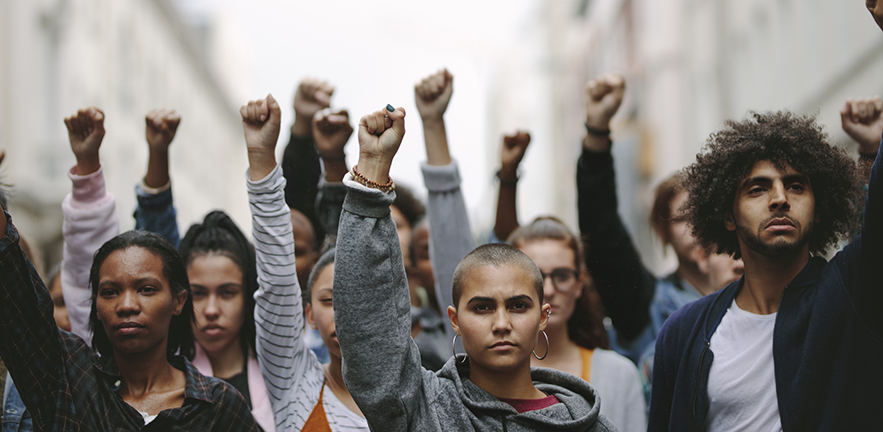Written by Ineka Hogge, student of MSc in Management (Supply Chains Logistics), Durham University and volunteer for the Cambridge Centre for Social Innovation.

Generation Z and scaling social movements
At the age of 22, I belong to Generation Z, defined as individuals born from 1995-2020: we are inherently digitalised in our nature as the ‘digital natives’ who grew up alongside instantaneous social media technology and digital innovations. Upon Lockdown 1.0, many of us were inextricably tied to social media and with that came the extensive and shocking viewing of the George Floyd murder. Despite Black Lives Matter (BLM) arising in 2012 from the murder of Trayvon Martin, the movement was resurged in protest of the murder of George Floyd and became the momentous social movement of the decade (Pellow, 2016).
The devastating footage was shot by Darnella Frazier who singlehandedly sparked a worldwide outcry: we learnt we can no longer be complicit in racial inequality (and sought justice for George Floyd) and a teenager was able to change the lens of the world with rapid thinking and modern technology. Living on a rural Scottish island, and like many across the globe, I had been naïve to the extent of this social injustice and became increasingly ashamed in my futile identifying of systemic racism prior learning about George Floyd’s death. However, social media became a portal of unfiltered user-generated content on the brutalisation of Black citizens. As I watched and read more of the content across various social media platforms, I witnessed a rise in the need to understand the root of racist brutality as the Black Lives Matter narratives surged, with George Floyd as the figurehead.
A few months later I was selecting a dissertation topic for my last year of MA (Hons) in International Business Management degree and I sought reflection on an area of business which was truly transformed in the pandemic. In times of uncertainty, the pandemic has brought to light our embedded relationship with digital communications. Social media has evolved past its original utilities to a necessity in propelling 21st-century social movements into the public sphere, which previously may have been undocumented or exclusively accessible in mainstream news (Freelon, McIlwain and Clark, 2018: Carney, 2016). The pursuit of focusing the research on Generation Z was founded upon the discussed ideal that this generational group are the most digitally connected and liberated consumers with strong values of radical thinking of social change to reverse the systemic prejudice allowed by our predecessors (Fromm and Read, 2018).
Implementation of social marketing with evolving consumer expectations
In times of COVID-19, the sudden stagnancy upon our everyday ‘hustle’ has allowed us to seek a deeper understanding of our societal trajectory and the barriers hindering quantifiable/real social change. Our taking a pause has motioned societal change to be at the forefront of our minds and brands have been called to action with reshaped marketplace expectations (Vredenburg, Kapitan, Spry and Kemper, 2020: Dibb, and Carrigan, 2013). My expectations as a consumer are evolving past functional utility and aesthetics and rather towards companies embodying social good in the core of its processes and ethos. Genuine social marketing allows both myself and fellow consumers to facilitate emotional connections between my beliefs and the brands’ ethical values (Wood 2000: McDivitt 2003). However, social marketing alone is a quick fix, and a brand’s support of BLM in the social media sphere should be reflective of a brand’s proactivity in equality in leadership and company opportunities.
Practices of ‘social marketing’ and ‘brand activism’ have arisen from the changing dynamics of the brand to consumer communications on the dissemination of social issues (Freelon, McIlwain and Clark, 2018). I believe it is becoming increasingly necessary to explore brands that are evolving past marketing of capital maximisation to promote social good to remit increased adoption of positive behaviour and the acceptability of a social idea integrate brand values with social change ethos (Dann, 2010: McDivitt, 2003: Lefebvre, 2011).

Black History Education
Education on racial inequality in a rural, dominantly white Scottish high school was short-lived and futile in informing students on microaggressions, current oppressions and insights on worldwide systemic injustice. Indeed, for me during the UK’s first lockdown it became clearer that learning “how not to be racist” rather than seeking a committed position of allyship was only further mediating a spinning wheel of oppression and privilege.
Black Lives Matter’s intrinsic link to the digital sphere reflects the modernised form of social movements in pertaining an expansive reach with #BlackLivesMatter being shared 11.8 million times on Twitter between mid-2013 and March 2016 (Anderson & Hitlin, 2016). The digital transmission of Black Lives Matter allowed education upon both the public and corporations on the widespread brutality and injustices but also the work which must be done. It also facilitates brands to utilise their strong social media grasp to mobilise social justice movements by sharing resources, donations, and importantly changes in their own company operations (Freelon, McIlwain and Clark, 2018).
The relationship between brand activism of Black Lives Matter on consumer brand equity of Generation Z
The basis of my dissertation encompasses the idea that we are becoming increasingly cognisant of privilege and beginning to challenge corporations and the systems themselves at the intersection of propelling real change. Despite focusing on the impact of BLM marketing, idealistic social marketing can further perpetuate an issue by ‘woke washing’ rather than corporations becoming changemakers in societal stagnancy.
Through surveys and research for my dissertation, I found the value of a brand is shaped – both positively and negatively – by the genuine implementation of BLM activism. Lockdown in 2020 saw a Twitter exchange in which both Yorkshire Tea and PG Tips utilised the #solidaritea to iterate their unity against inequality in their brand practices by taking momentary pause to educate themselves to implement well-grounded action. Despite previous allegations of woke washing, Nike is showcasing commitment to racial equality in marketing but more importantly its leadership inclusivity, alongside brands like Ben & Jerry’s who are rooted in social awareness and involvement by intertwining social issues within marketing campaigns and operations (Liu, Kim and Alharbi, 2020). I believe the future consumer landscape will be founded upon consumers developing meaningful brand connections who strive past complicit action in racial inequality.
I reviewed the concept of self-similarity which surrounds consumers’ alignment to brand values which can shorten the exchange process and has the power to increase brand loyalty and the value of a brand (Engelberg and Kirby, 2001: Lefebvre 2013). I found that a generation powered by sharing thoughts and attitudes has reinvigorated confrontational politics, with results showing more favourable associations and higher loyalty to a brand with high self-similarity in ethics.
Despite my research assuming a strong correlation between brand activism of Black Lives Matter on the consumer brand equity of Generation Z, I lean towards the idea Generation Z were gloried into an ideal. An ideal that the actions of social media reshares, posts of support, and posting black boxes do not transcend in consumer actions but positively social media has allowed modern society to engage in international conversations about racial discourses and political responsibility in corporations. It could mark the ending of acquiescence on racial inequality by spurring conversations and powers companies to sincerely mobilise pressing social issues.
References
Anderson, M. & Hitlin, P. (2016). Social Media Conversations About Race: How social media users see, share and discuss race and the rise of hashtags like #BlackLivesMatter. Pew Research Center
Carney, N., (2016). ‘All lives matter, but so does race: Black lives matter and the evolving role of social media. Humanity & Society’, 40(2), pp.180-199.
Dann, S. (2010). ‘Redefining social marketing with contemporary commercial marketing definitions’. Journal of Business research, 63(2), pp.147-153.
Dibb, S. and Carrigan, M. (2013). Social marketing transformed. European Journal of Marketing.
Engelberg, M. and Kirby, S.D. (2001). Identity building in social marketing. Social Marketing Quarterly, 7(2), pp.8-15.
Forman, J. and Damschroder, L. (2007). Qualitative content analysis. In Empirical methods for bioethics: A primer. Emerald Group Publishing Limited.
Freelon, D., McIlwain, C. and Clark, M. (2018). ‘Quantifying the power and consequences of social media protest’, New Media & Society, 20(3), pp.990-1011.
Fromm, J. and Read, A. (2018). ‘Marketing to Gen Z: The rules for reaching this vast and very different generation of influencers’. Amacom. Vancouver
Lefebvre, R.C., (2011). ‘An integrative model for social marketing’, Journal of Social Marketing. Vancouver
Liu, J.Y., Kim, J.K. and Alharbi, K. (2020). ‘Exploring the role of issue involvement and brand attachment in shaping consumer response toward corporate social advocacy (CSA) initiatives: the case of Nike’s Colin Kaepernick campaign’, International Journal of Advertising, pp.1-25.
McDivitt, J. (2003). Is there a role for branding in social marketing?
Pellow, D.N. (2016). ‘Toward a critical environmental justice studies: Black lives matter as an environmental justice challenge’, Du Bois Review: Social Science Research on Race, 13(2), pp.221-236.
Vredenburg, J., Kapitan, S., Spry, A. and Kemper, J.A. (2020). ‘Brands Taking a Stand: Authentic Brand Activism or Woke Washing?’, Journal of Public Policy & Marketing, 39(4), pp. 444-460.
Wood, L. (2000). “Brands and brand equity: definition and management”, Management Decision, Vol. 38 No. 9, pp. 662-9


Leave a Reply